Understanding Diffuse Intrinsic Glioma: Comprehensive Overview
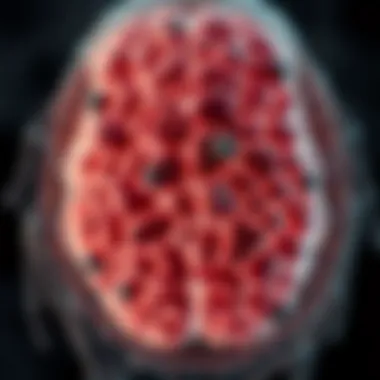
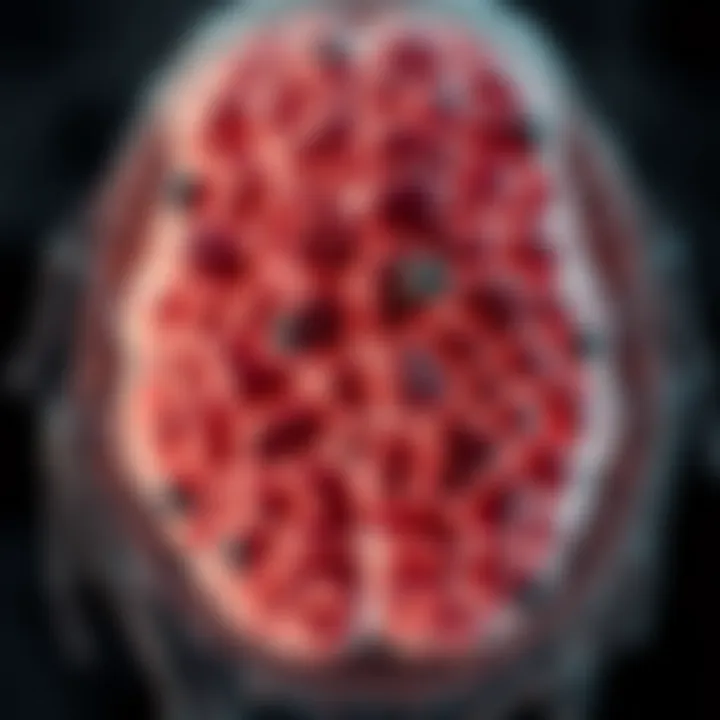
Intro
Diffuse intrinsic glioma (DIG) poses a significant challenge within the field of neuro-oncology, particularly due to its pervasive nature and tendency to affect mainly children. The complexity of this type of tumor necessitates an in-depth understanding that takes into account not only its biological characteristics but also its profound implications for patients and their families. This article aims to bring clarity to the multifaceted nature of DIG through a comprehensive overview of its pathology, diagnosis, treatment protocols, and the contemporary landscape of research.
In recent years, the challenges presented by DIG have gained more attention, prompting further investigation into innovative treatment strategies and patient care. The integration of insights drawn from various disciplines—including molecular biology, pediatrics, and psychology—will enhance our grasp of these tumors, equipping both researchers and practitioners with the knowledge required to tackle the complexities of DIG.
Article Overview
Purpose of the Article
The primary aim of this article is to serve as a guide for a wide audience: students, researchers, educators, and healthcare professionals. By elucidating the intricacies of DIG, this piece will contribute to a greater understanding of how these tumors develop, how they present in clinical settings, and the ramifications for diagnosis and treatment.
Relevance to Multiple Disciplines
Addressing DIG requires a multidisciplinary approach. The relevance of this subject spans across various fields:
- Neuroscience: Understanding the tumor's biological behavior and its interactions within the neural environment.
- Pediatrics: Focusing on how these tumors manifest in children and the specific challenges concerning their treatment and prognosis.
- Psychology: Recognizing the emotional and psychological effects on patients and families, emphasizing the need for comprehensive support systems.
This intersection of disciplines not only enriches the discourse surrounding DIG but also fosters collaboration toward more effective solutions.
Research Background
Historical Context
The history of diffuse intrinsic gliomas is intertwined with advancements in neuroimaging and surgery. The term has evolved as medical technologies have progressed, allowing for improved detection and classification. Older approaches often resulted in less favorable outcomes due to the aggressive nature of these tumors. As understanding in this area deepened, researchers began to explore new avenues of treatment and care.
Key Concepts and Definitions
Understanding DIG involves several key concepts:
- Infiltrative Behavior: This characteristic denotes how tumors spread seamlessly into adjacent brain tissue, making surgical removal incredibly difficult.
- Histopathological Features: Characteristics observed under microscopic examination that aid in accurate diagnosis, which includes cellular morphology and growth patterns.
- Molecular Subtypes: Variations of DIG that can influence treatment responses and outcomes, paving the way for personalized medicine.
"Diffuse intrinsic glioma remains one of the most formidable challenges in pediatric neuro-oncology, due not only to its biological complexities but also to the profound impact on young patients and their families."
"Diffuse intrinsic glioma remains one of the most formidable challenges in pediatric neuro-oncology, due not only to its biological complexities but also to the profound impact on young patients and their families."
The exploration of these features sets the foundation for understanding the complexities associated with diagnosis and treatment, forming a narrative that underscores the urgency for continuous research and innovation.
Prologue to Diffuse Intrinsic Glioma
Diffuse intrinsic glioma is a critical area of research and clinical focus, particularly due to the nature of these tumors and their impact on predominantly pediatric populations. Characterized by their infiltrative growth patterns, these tumors tend to evade traditional surgical interventions, making early detection and accurate diagnosis both crucial and challenging. Understanding diffuse intrinsic glioma is not just a matter of academic interest; it holds profound implications for treatment outcomes and patient quality of life.
Importance of the Topic
The significance of studying diffuse intrinsic glioma lies in its complex pathology and the challenges associated with management.
- Evolving Treatment Protocols: As our understanding of glioma biology advances, treatment protocols are continuously adapting. The nuances of these tumors demand a keen insight into new therapies, both surgical and adjunctive.
- Interdisciplinary Insights: This condition often requires a blend of expertise from neurology, oncology, radiology, and pathology, illustrating the importance of collaboration in improving patient care.
- Advocacy for Awareness: Increased awareness among healthcare providers and the general public can lead to earlier diagnosis and intervention, which is often linked to better prognostic outcomes.
In diving deeper into the complexities of diffuse intrinsic glioma, this section serves as the foundational element of our comprehensive article. It guides the reader through current understanding and the ongoing evolution of clinical strategies, highlighting why this area demands our focused attention. Moreover, a strong grasp of diffuse intrinsic glioma is pivotal for professionals in the field, as it equips them with the tools to navigate the intricacies of patient management and offer informed care.
"The understanding of diffuse intrinsic glioma is not static; it is a dynamic field where ongoing research shapes the horizon of treatment options and supports the quest for better patient outcomes."
"The understanding of diffuse intrinsic glioma is not static; it is a dynamic field where ongoing research shapes the horizon of treatment options and supports the quest for better patient outcomes."
By laying out the groundwork here, we prepare the ground for a detailed exploration of glioma classification, characteristics, and the latest advancements in treatment, ultimately aiming to enhance knowledge and foster better communication among practitioners and researchers.
Classification of Gliomas
Understanding the classification of gliomas serves as a cornerstone for diagnosing and treating these complex tumors. Gliomas are categorized based on their cellular origin, histological features, and the molecular characteristics that define their behavior. This stratification is not just a semantic exercise; it provides essential insights into prognosis, treatment modalities, and potential responses to therapy. Recognizing the different classifications empowers healthcare professionals to tailor treatment plans and informs patients and their families about the disease trajectory.
Types of Gliomas
Astrocytomas
Astrocytomas are a significant subgroup of gliomas that originate from astrocytes, which are star-shaped glial cells in the brain. One defining characteristic of astrocytomas is their ability to infiltrate surrounding brain tissue, making complete surgical removal challenging. They can range from low-grade to high-grade, with higher-grade astrocytomas, like glioblastomas, being particularly aggressive and associated with poor prognosis.
These tumors are popular in this article due to their common occurrence and their impact on clinical outcomes. One unique feature of astrocytomas is their variably shaped cells and nuclear atypia seen in pathology. This can aid physicians in making initial diagnoses and formulating immediate treatment strategies.
However, the infiltrative growth of astrocytomas often complicates interventions, leading to significant neurological deficits. The balance of understanding their aggressive nature while honing in on the therapeutic target is the crux of ongoing research in the field.
Oligodendrogliomas
Oligodendrogliomas are another type of glioma, arising from oligodendrocytes. They typically present a more favorable prognosis than astrocytomas, particularly when they have a deletion of the 1p and 19q chromosomal arms. This genetic marker is critical for diagnosis and influences treatment decisions, making oligodendrogliomas a significant subject in our discourse on glioma classifications.
Their characteristic appearance under the microscope, often described as "fried egg" cells, adds a layer of intrigue to the histopathology. This unique feature provides a visual pathway for diagnosing these tumors, which may lead to more effective management options. However, while oligodendrogliomas may respond well to chemotherapy and radiation, they still pose significant treatment challenges due to their invasive nature.
Ependymomas
Ependymomas arise from the ependymal cells lining the ventricles of the brain and the central canal of the spinal cord. Unique to ependymomas is their location-related presentation; for instance, those found in the fourth ventricle can cause obstructive hydrocephalus. They tend to be slow-growing tumors but can reoccur after treatment, thus presenting challenges even when they are considered low-grade.
Ependymomas are highlighted here because they illustrate the diverse array of gliomas and their varied clinical behavior. Their histological features, such as perivascular pseudorosettes, are advantageous for pathologists during diagnosis. Nonetheless, when it comes to treatment, achieving complete surgical resection remains a demanding hurdle.
Grading of Gliomas
Low-Grade Gliomas
Low-grade gliomas, typically classified as WHO grades I and II, are generally slow-growing and less aggressive compared to their high-grade counterparts. One of the key characteristics of low-grade gliomas is that they often present with subtle symptoms, making early diagnosis a challenge. In fact, many patients may live for years with undiagnosed tumors.
Their inclusion in this article is crucial for understanding the spectrum of gliomas and offering insight into prognosis. Low-grade gliomas are lentiginous, often providing a better long-term outlook if managed appropriately. Yet, they do possess unique variants that may transform into higher-grade tumors, thus necessitating regular monitoring.
High-Grade Gliomas
High-grade gliomas, like glioblastoma multiforme, are notorious for their aggressive nature and poor prognosis. These tumors, classified as WHO grades III and IV, infiltrate brain tissue rapidly and are often diagnosed at advanced stages.
The significance of high-grade gliomas in this discussion can't be understated. They commonly present with severe neurological deficits and a grim prognosis, emphasizing the urgent need for effective treatment strategies. One notable feature of high-grade gliomas is the presence of necrosis and significant cellular atypia, markers easily identified through imaging and histological analysis.
Although current treatments exist, including aggressive surgical resection, radiation, and chemotherapy, high-grade gliomas remain a formidable opponent in neuro-oncology. Understanding their classification aids in refining management strategies and sparking new avenues for research.
Characteristics of Diffuse Intrinsic Glioma
The characteristics of diffuse intrinsic glioma (DIG) are pivotal in understanding its impact on diagnosis, treatment, and patient outcomes. Recognizing the unique features of these tumors helps scientists and clinicians navigate their complexities. This section sheds light on the pivotal aspects that define DIG, particularly focusing on histopathological features and genetic mutations that are common in these tumors.
Histopathology
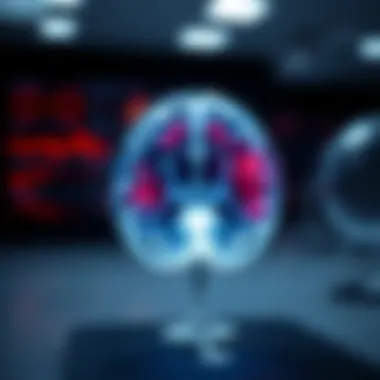

Infiltrative Nature
The infiltrative nature of diffuse intrinsic gliomas is one of their hallmark features. Unlike well-defined tumors, DIG tends to extend into surrounding brain tissue, making complete surgical removal a daunting challenge. This characteristic plays a significant role in tumor behavior, as it complicates both diagnosis and therapy.
A key characteristic of this infiltrative nature lies in the tumor's ability to intertwine with healthy neuronal tissue, often leading to a poor prognosis. On one hand, this integration enhances the tumor's growth potential, but on the other hand, it poses a great difficulty for effective resection. The nuanced invasion means that even a seemingly successful surgery may leave residual tumor cells behind, potentially leading to recurrence.
Moreover, the infiltrative behavior highlights the necessity for advanced imaging techniques and treatment strategies tailored to address this specific challenge. The understanding of this infiltrative approach continuously evolves, incorporating new research in neuroimaging and targeted therapies. However, the downside is the increased complexity in assessing tumor margins during surgical planning.
Cytological Features
When analyzing the cytological features of diffuse intrinsic glioma, researchers note that the tumor exhibits distinct cellular atypia. These atypical cells can include variations in size, shape, and arrangement, which help in differentiating DIG from other brain neoplasms. One notable aspect is the presence of multinucleated giant cells that often characterize these tumors, acting as indicators during histological evaluations.
Cytological features also encompass the tumor’s heterogeneous cellular makeup. This diversity can provide insights into the tumor's biological behavior, with implications for treatment strategies. The presence of various cell types, along with their growth patterns, informs the oncologist regarding the aggressiveness of the tumor. Thus, understanding these cellular characteristics is vital for accurate diagnosis and prognostic assessments.
The uniqueness of these cellular presentations allows pathologists to utilize specific markers for identification and classification. However, this variability can complicate the standardization of treatment approaches, as different cellular behaviors may respond differently to therapies.
Genetic Mutations
ID and ID Mutations
ID and ID mutations serve a crucial role in the pathogenesis of diffuse intrinsic gliomas. These genetic alterations often initiate the transformation of normal astrocytes into tumor cells. The presence of such mutations signifies a distinct subset of gliomas that can have varying prognoses.
A key characteristic of IDH mutations is their association with a better overall survival compared to wild-type tumors. This mutation alters metabolic pathways, leading to the production of oncometabolites that influence cellular behavior. Understanding these mutations aids in stratifying patients for potential targeted therapies, making them a preferential area of focus in current research.
On the downside, restaging dilemmas may arise as patients with these mutations might not respond uniformly to therapies aimed at other glioma types. This inconsistency underscores the importance of genetic testing in the clinical management of glioma patients.
TP53 and ATRX Alterations
TP53 and ATRX alterations are also integral to the molecular landscape of diffuse intrinsic gliomas. TP53 serves as a critical tumor suppressor, and its mutation often leads to disrupted cell cycle regulation. As a result, tumors harboring this alteration tend to show aggressive behaviors and can present significant treatment challenges.
ATRX plays a role in chromatin remodeling and, like TP53, its mutation can lead to genomic instability. This instability is a double-edged sword; while it may enhance tumor evolution, it can also open avenues for innovative therapies targeting specific genomic vulnerabilities. Drifting focus towards these alterations offers a promising direction for developing new treatment protocols.
However, the high prevalence of these mutations in certain glioma types indicates that relying solely on them for therapeutic strategies could oversimplify the complexity of DIG. The interplay of various mutations means that a multifaceted approach remains essential.
The intricate characteristics of diffuse intrinsic glioma highlight the complexities faced in both clinical management and research, emphasizing a need for continual evolution in treatment paradigms.
The intricate characteristics of diffuse intrinsic glioma highlight the complexities faced in both clinical management and research, emphasizing a need for continual evolution in treatment paradigms.
Through exploring the histopathology and the genetic profile of diffuse intrinsic gliomas, clinicians can better navigate the waters of this challenging disease. The insights gained will help shape future research as well as therapeutic approaches, promoting a more tailored management strategy for patients.
Epidemiology of Diffuse Intrinsic Glioma
Epidemiology plays a crucial role in understanding diffuse intrinsic glioma (DIG), particularly in identifying who is affected, the prevalence rates, and other salient factors that shape the clinical landscape. Knowing the epidemiological framework can inform both research and clinical practices — guiding new strategies for prevention, late diagnosis, and treatment methodologies.
Understanding the incidence and demographic variations helps paint a comprehensive picture of this complex tumor type. The data often informs healthcare policies and resource allocation, ensuring that those areas with higher incidence receive adequate support and research focus.
Incidence Rates
The incidence rates of diffuse intrinsic glioma provide vital insights into how prevalent these tumors are in populations. Studies indicate that DIG mainly affects children, particularly those aged between 5 and 10 years. According to various databases and health agencies, incidence rates vary, but they usually range around 4-5 cases per 100,000 pediatric population annually. These numbers highlight that while rare, DIG is not a negligible concern.
A prominent feature of these figures is that there appears to be an upward trend in the recognition and diagnosis of these tumors. Increased imaging capabilities and awareness among healthcare professionals contribute to this observance of higher incidence. This might make it seem like there's an increase where, in reality, it's more about improved detection rather than an actual jump in cases.
Demographic Factors
Demographic factors surrounding diffuse intrinsic glioma reveal distinct patterns that can aid in understanding why some populations seem more affected than others.
Age Cases
The age distribution of DIG cases is a significant aspect when discussing its epidemiology. Most commonly diagnosed in children, peaks usually manifest between the ages of 5 and 8. This particular age range is notable because it coincides with critical developmental stages; therefore, understanding the age distribution is vital for clinicians and caregivers alike. The unique feature of these age cases lies in their association with developmental biology, thus making it an essential topic of exploration. Recognizing this pattern facilitates better monitoring and potentially allows for earlier intervention.
However, the flipside is that the rarity of these cases in older populations can lead to a lack of research and clinical focus on adult patients, a crucial gap that feeds into the larger challenge of recognizing symptoms in older age groups.
Gender Distribution
When discussing gender distribution in the context of diffuse intrinsic glioma, it's crucial to note that while both sexes can be affected, there tends to be a slightly higher prevalence in males. Studies often indicate that the ratio is roughly 1.5:1 in favor of males. Understanding this gender tendency is not just about numbers; it can help unravel underlying biological mechanisms that contribute to tumor development.
An essential part of this discussion is how the male predominance could guide therapeutic approaches, as drugs interacting with biological systems may work differently across genders. However, a potential disadvantage is that focusing too much on gender disparities can inadvertently overlook the equally rising cases in females, which warrants more focused research and awareness initiatives.
As we further uncover the epidemiology of diffuse intrinsic glioma, understanding the nuances of incidence and demographics can pave the way for targeted therapies and better patient outcomes.
As we further uncover the epidemiology of diffuse intrinsic glioma, understanding the nuances of incidence and demographics can pave the way for targeted therapies and better patient outcomes.
Resources:
- Centers for Disease Control and Prevention (CDC)
- National Cancer Institute (NCI)
- Wikipedia - Glioma
- American Brain Tumor Association
Clinical Presentation
Clinical presentation holds significant weight in understanding diffuse intrinsic glioma (DIG). It encompasses the initial signs and symptoms which reveal much about how the tumor affects both the brain and the body. Recognizing these manifestations early can be crucial in determining the course of treatment. This section will discuss the key aspects that define the clinical presentation of DIG, focusing on neurological deficits and seizures, followed by the crucial methods utilized for diagnosis.
Symptoms
Symptoms often serve as the first clues that lead to a diagnosis of diffuse intrinsic glioma. These manifestations unfold as unique neurological traits that alert medical professionals to investigate further.
Neurological Deficits
Neurological deficits are a hallmark symptom of diffuse intrinsic glioma, playing a crucial role in understanding the extent of the tumor's influence on the nervous system. These deficits can manifest in various forms, including difficulty with motor skills, speech impairments, or sensory changes. One key characteristic of neurological deficits in DIG is that they can be both localized and diffuse, highlighting the tumor's infiltrative nature.
Recognizing these deficits early can lead to timely intervention, enhancing patient outcomes. The unique feature of these deficits is their variability; they can differ dramatically from one individual to another, depending on the tumor's location and size. This variability can be both an advantage, as it prompts various diagnostic evaluations, and a challenge, as it may complicate the timeline of diagnosis and treatment.
Seizures
Seizures represent another critical symptom associated with diffuse intrinsic glioma. Often, they can be the first noticeable sign of a brain abnormality, bringing the necessity of further investigation into play. A common characteristic of seizures in this context is their potential to be focal or generalized, driven by the tumor's stimulating effects on brain tissue.
Seizures due to DIG pose both opportunities and obstacles in the clinical setting. On one hand, they can serve as an urgent indication to begin diagnostic protocols. On the other hand, the unpredictability of seizure types may complicate treatment strategies. The unique feature here is that not all seizures experienced by patients are indicative of tumor activity; sometimes they may stem from treatment-related factors or other pathological processes, making accurate assessment vital.
Diagnosis
Proper diagnosis underpins the understanding and management of diffuse intrinsic glioma. Various techniques are employed to determine the presence, extent, and type of tumor.
Imaging Techniques
Imaging techniques, such as MRI or CT scans, are essential tools in diagnosing diffuse intrinsic glioma. Their primary contribution lies in providing detailed visual representations of brain structures, allowing clinicians to identify tumors’ size and location accurately. One important characteristic of imaging techniques is their ability to assess not only the tumor itself but also the surrounding brain tissues, revealing any potential swelling or structural changes.
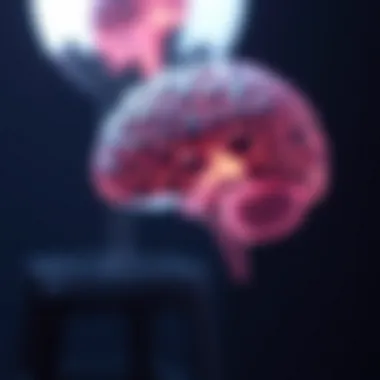
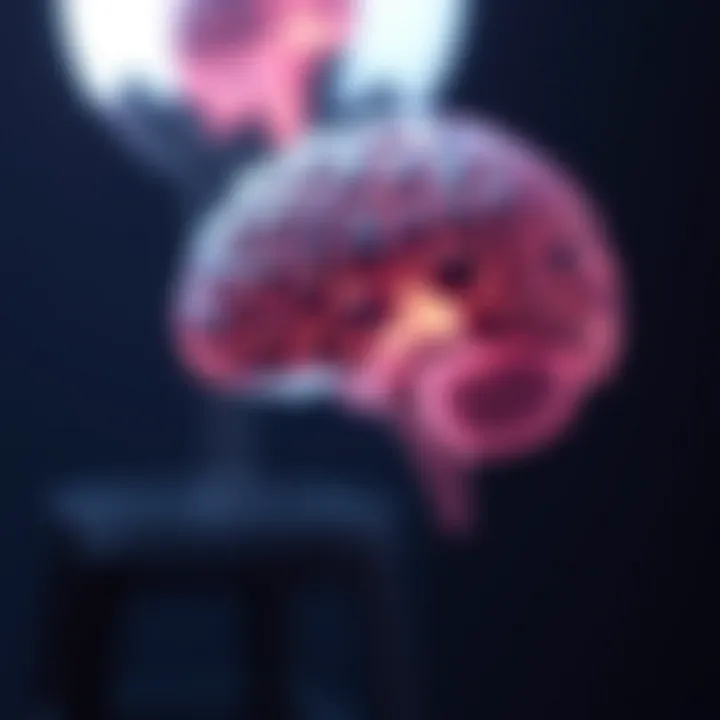
In this context, MRI has gained popularity due to its high-resolution images, which are particularly beneficial in visualizing the infiltrative characteristics of DIG. The advantage of using these imaging modalities is that they are non-invasive and can be performed multiple times to monitor tumor progression. However, a disadvantage is that they may not provide definitive information about cellular makeup, necessitating further tests like biopsy.
Biopsy Procedures
Biopsy procedures are a fundamental part of the diagnostic landscape for diffuse intrinsic glioma. The process involves obtaining a tissue sample from the tumor for histopathological examination. This step is integral, as it allows for the confirmation of the tumor type and grade, which are pivotal for tailoring treatment strategies.
A notable advantage of biopsy procedures is their capacity to yield not just critical diagnostic information, but also insights into the genetic mutations present in the tumor, which can influence treatment options. However, a drawback is that these procedures can pose risks, such as infection or bleeding, and may not always access the tumor tissue due to its diffuse nature. Thus, the decision to proceed with biopsy is one that requires careful consideration, balancing risks with potential benefits.
Treatment Options
In the realm of diffuse intrinsic glioma, understanding treatment options stands as a crucial pillar. This approach serves as a compass, guiding both patients and healthcare professionals through the intricate web of available interventions. With gliomas being notoriously difficult to treat due to their diffuse nature, exploring these options is not just an academic exercise but a vital necessity for improving patient outcomes. Each method—surgery, radiation, and chemotherapy—carries its own weight of benefits and considerations.
Surgical Approaches
Resection Strategies
Surgical resection is often considered the first line of defense against diffuse intrinsic glioma. It aims to physically remove as much of the tumor as possible, facilitating control over the tumor's growth. The key characteristic of resection strategies in this context is the extent to which the tumor can be excised while preserving surrounding healthy tissue. This delicate balance makes it a popular choice for many clinicians.
One unique feature of resection is the use of intraoperative imaging techniques, which can significantly enhance precision during the surgery. This minimizes damage to critical brain structures, thereby reducing postoperative complications. However, the efficacy of resection is heavily dependent on tumor location; if a tumor is deeply seated in eloquent brain areas, complete removal may not be feasible. This presents an obvious disadvantage, as residual tumor cells can lead to recurrence. It’s a complex dance that requires the surgeon to be as precise as a watchmaker.
Challenges in Surgery
Surgery, while often effective, is not without its challenges. The primary characteristic of these challenges is rooted in the infiltrative behavior of gliomas; these tumors tend to extend their tendrils into surrounding brain tissue, making it nearly impossible to achieve complete removal without risking significant neurological deficits.
A unique feature of surgery challenges includes the potential for postoperative complications, like infections or neurological deficits, which can significantly impact the patient’s quality of life. While the prospect of surgery might seem straightforward, each case requires a tailored approach, and the decision to operate must weigh urgent benefits against long-term consequences. Another layer of complexity arises when considering the psychological toll on patients and families, as they navigate the uncertainty of recovery and the possibility of recurrence.
Radiation Therapy
Techniques
Radiation therapy stands as a beacon of hope in the treatment landscape of diffuse intrinsic glioma, particularly for those tumors that are not amenable to surgical approach. The key characteristic of radiation techniques is their ability to target tumor cells with precision, aiming to destroy them while sparing normal brain tissue. Techniques such as stereotactic radiosurgery or fractionated radiotherapy have gained traction for their ability to deliver high doses of radiation accurately.
One unique aspect of these techniques is the use of advanced imaging modalities that allow for real-time adjustments during treatment sessions. This kind of adaptive therapy can enhance the effectiveness of the treatment. Nonetheless, it comes with its own set of challenges, as elevated doses of radiation might raise the risk of damage to surrounding healthy tissue, leading to complications such as radiation necrosis.
Potential Side Effects
Despite its importance, radiation therapy does carry potential side effects that patients must contend with. The hallmark of these potential side effects includes fatigue, skin reactions, and cognitive changes, which can severely impact daily life.
The unique feature of these side effects is that they may not become apparent until weeks after treatment, which can catch patients off guard. While radiation acts to halt tumor growth, the aftermath can be a double-edged sword, leading to significant struggles in managing quality of life. Still, understanding these risks in advance helps to foster open conversations between patients and their care teams, equipping them with strategies to manage side effects proactively.
Chemotherapy Regimens
Common Agents
Chemotherapy has historically had a role in managing gliomas, particularly in tandem with surgery and radiation. While the effectiveness of chemotherapy remains a nuanced topic, the use of common agents like temozolomide is pivotal. These agents work by attacking rapidly dividing cells, particularly malignant ones. The main characteristic of these common agents is their ability to cross the blood-brain barrier, a significant challenge in treating central nervous system tumors.
A unique feature of temozolomide, for example, is its oral administration, allowing for enhanced patient compliance compared to intravenous options. Despite this convenience, the downside is the potential for severe side effects like nausea, fatigue, and myelosuppression, compromising the immune system and making patients more susceptible to infections.
Efficacy and Limitations
In assessing the efficacy and limitations of chemotherapy, one must look closely at its overall impact on glioma treatment. Although it can prolong survival in some cases, the limitations often lie in the tumor's inherent resistance to therapy, which further complicates treatment protocols.
A key characteristic of these limitations includes the variability in response among individual patients. Not every patient will react in the same way to chemotherapy, which raises questions of personalization and adaptability in treatment. It’s a stark reminder that while chemotherapy can play a role in the management of diffuse intrinsic glioma, it is not a silver bullet. Ultimately, a multidisciplinary strategy is often required to navigate these complex layers of treatment options effectively.
Emerging Therapies
Emerging therapies represent a beacon of hope in the realm of diffuse intrinsic glioma (DIG) treatment. Recent advancements in medicine have paved the way for innovative strategies that focus on uniquely targeting the tumor's biology. One key advantage of these therapies is their potential to minimize harm to surrounding healthy tissues while maximizing therapeutic effects on cancer cells. This embodies a shift from traditional approaches that often involve broad-spectrum treatments like chemotherapy and radiation.
Targeted Therapies
Targeted therapies hone in on specific molecular alterations that are prevalent in gliomas. Unlike conventional treatments that may side-swipe cancer cells in a scattergun fashion, these therapies aim at specific pathways or genetic mutations that fuel tumor growth. For instance, drugs targeting the EGFR mutation show promise; by inhibiting this receptor, which is often overexpressed in glioblastomas, there's a potential to stunt tumor progression.
Utilizing small molecule inhibitors or monoclonal antibodies, the ideal target is not only the tumor but also any supporting immune or cellular elements that assist it. This precision is what distinguishes targeted therapies, allowing a more calculated attack on the tumor while often sparing the patient from extensive side effects.
"Targeted therapies offer the potential for more effective treatment options while aiming to preserve the quality of life similar to a careful sculptor refining their masterpiece."
"Targeted therapies offer the potential for more effective treatment options while aiming to preserve the quality of life similar to a careful sculptor refining their masterpiece."
Immunotherapy Innovations
Immunotherapy is another rapidly evolving discipline that employs the body’s own immune system to combat gliomas. Recent studies discuss the development of checkpoint inhibitors, which work by lifting the "brakes" on immune cells that may have been suppressed by tumor mechanisms. These medications reinvigorate the immune response against gliomas, possibly transforming how physicians approach treatment.
A noteworthy area gaining traction is the use of CAR T-cell therapy. This novel technique involves engineering T-cells to target specific antigens present on the glioma cell surface, such as IL13Rα2. While clinical data regarding its efficacy in DIGs is still emerging, early results are cautiously optimistic. The possibility of reprogramming T-cells to become tumor-killers opens up new vistas in managing this historically challenging type of tumor.
The enhanced understanding of glioma biology has sparked these innovations, converting insights into applicable treatments that could improve patient outcomes significantly. Both targeted therapies and immunotherapy innovations represent a paradigm shift in the treatment landscape for diffuse intrinsic gliomas, pushing the envelope on what is possible in the fight against these complex tumors.
For further details, you can refer to National Cancer Institute.
Additionally, resources such as NCI’s Science of Cancer provide in-depth information on the current state of cancer therapies.
Challenges in Management
Managing diffuse intrinsic glioma (DIG) is a complex endeavor that requires a multifaceted understanding of both the biological characteristics of the tumor and the unique patient needs. The management challenges are not merely clinical; they extend to psychological, financial, and social dimensions, making it imperative to approach treatment from a holistic viewpoint. The affected individuals often include pediatric patients, where implications on development and family dynamics are especially profound. Thus, a thorough exploration of these challenges can illuminate potential pathways toward more effective care.
Resistance to Therapy
One of the significant hurdles in the management of DIG is resistance to therapy. This issue arises from the infiltrative nature of the tumor, which makes complete surgical removal nearly impossible. As a result, even with aggressive treatment, residual tumor cells can continue to grow and mutate, leading to therapy resistance.
The biological underpinnings of the DIG may include various genetic mutations, like alterations in ID and TP53, that allow tumor cells to adapt and survive against conventional treatments. Not only does this adaptability hinder the effectiveness of traditional chemotherapy agents, but it also underscores the necessity for ongoing research into personalized therapy options. The emergence of new targeted therapies aims to minimize these resistances but often require extensive clinical trials before they become part of standard treatment regimens.
- For instance, therapies targeting specific mutations observed in patient tumors may improve outcomes. It's crucial to note that the identification of such mutations necessitates sophisticated diagnostic tools and expertise.
- Furthermore, clinical trials focusing on combination therapies are being explored, potentially offering hope for more favorable responses against resistant tumor cells.
The search for solutions is ongoing, and scientists continually strive to untangle the complexities of resistance in order to refine and enhance treatment protocols.
Quality of Life Considerations
When tackling the management of DIG, quality of life considerations cannot be ignored. As treatment often involves significant physical and emotional challenges, it’s essential to keep patient well-being at the forefront. This necessitates a broader look into how each treatment impacts life outside of clinical outcomes.
Patients, especially children, often face cognitive, emotional, and physical side effects due to invasive procedures like surgery, and long-term effects from radiation or chemotherapy can further complicate their daily lives. Careful monitoring of these side effects is essential in order to develop supportive care plans.
"In the face of a difficult diagnosis, maintaining a quality of life for both patients and their families is no small feat."
"In the face of a difficult diagnosis, maintaining a quality of life for both patients and their families is no small feat."
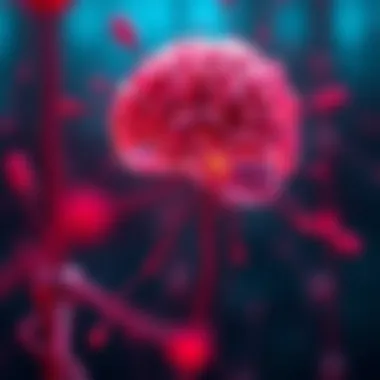

A few key aspects of quality of life to consider include:
- Cognitive Rehabilitation: Developing strategies to improve cognitive function may benefit patients experiencing difficulties post-treatment.
- Psychosocial Support: Counseling and support groups can provide crucial emotional respite and coping strategies for both patients and families.
- Holistic Care Approaches: Integrative methods, such as art or music therapy, can offer a sense of normalcy and community.
Understanding these quality-of-life metrics can help shape treatment plans that not only aim for longevity but also prioritize meaningful experiences during the treatment journey.
Research Directions
Research directions in diffuse intrinsic glioma (DIG) play a crucial role in advancing our understanding and management of this complex tumor type. As scientists and clinicians work collaboratively, the importance of identifying granular insights cannot be understated. The rapidly evolving landscape of glioma research is not only aimed at comprehending the biology but also focuses on improving patient outcomes through innovative therapies.
Emerging discoveries in this domain are providing fresh perspectives regarding the tumor microenvironment, genetic make-up, and treatment response. These directions open avenues for researchers to explore interventions that may lessen the burden of this devastating diagnosis. Therefore, continued investment in both fundamental and applied research is essential.
"The future of glioma treatment hinges on our ability to innovate through research. Each discovery can redefine our approach to managing these tumors."
"The future of glioma treatment hinges on our ability to innovate through research. Each discovery can redefine our approach to managing these tumors."
Recent Advances
Novel Biomarkers
Novel biomarkers serve as pivotal tools in the realm of diffuse intrinsic glioma research. Defining these markers contributes significantly to the understanding of tumor behavior, prognosis, and therapy response. For instance, the identification of specific molecules associated with tumor growth facilitates the development of targeted treatments.
A key characteristic of these biomarkers is their potential to predict patient outcomes, allowing for personalized therapeutic strategies. This is beneficial as it shifts the focus from a one-size-fits-all approach towards more tailored interventions.
Unique features in the context of novel biomarkers include their non-invasive nature and ease of monitoring over time. However, while promising, there remain challenges regarding their validation in clinical settings. Ensuring that these markers consistently correlate with clinical outcomes is fundamental.
Genomic Studies
Genomic studies have emerged as a cornerstone of glioma research, offering insights into the genetic alterations that underpin tumor development and progression. This avenue of research can unravel the complexities of glioma subtypes, helping to delineate variations that may influence prognosis and treatment responses.
A decisive characteristic of genomic studies is their ability to identify mutations that can be targeted with specific therapies. This can potentially lead to more effective treatment modalities, directly addressing the unique genetic landscape of a tumor.
One unique feature of genomic studies is the advent of next-generation sequencing technologies, which allow for comprehensive genomic profiling. This approach, however, brings its own set of challenges, such as the need for robust bioinformatics tools to analyze copious data and the interpretation of ambiguous results.
Future Clinical Trials
Future clinical trials are set to play a pivotal role in shaping the landscape of diffuse intrinsic glioma treatment protocols. These trials will not only test novel therapeutic agents but also explore combinations of existing treatments that could enhance efficacy.
Moreover, there’s a growing emphasis on the integration of biomarkers into trial designs, allowing for stratification based on individual tumor characteristics. This shift can significantly enhance the precision of treatments offered to patients, optimizing outcomes.
Additionally, the need for diverse participant demographics in clinical trials ensures that findings are applicable across different populations, addressing any disparities in response rates.
In summary, the direction of research in diffuse intrinsic glioma is geared towards uncovering novel biomarkers and genomic insights that could translate into enhanced therapeutic strategies. As clinical trials evolve to adapt these discoveries, they hold the promise of transforming outcomes for patients battling this challenging condition.
Multidisciplinary Approach
The management of diffuse intrinsic glioma (DIG) is no walk in the park. This type of tumor, especially prevalent in pediatric populations, demands a thorough and well-rounded approach that taps into the expertise of various medical fields. Without a doubt, a multidisciplinary approach serves as the backbone for effective treatment strategies, leading to more integrated patient care and improving outcomes. It brings together specialists from neurology, oncology, neurosurgery, and supportive care to forge a clear path through the complexities of this disease.
By collaborating across different disciplines, teams can provide a more comprehensive assessment of the patient’s situation. For instance, while neurosurgeons may focus on the surgical aspects of the tumor’s removal, oncologists can simultaneously develop an appropriate chemotherapy or radiation therapy regimen tailored to the patient’s specific tumor biology. Each specialty contributes to a holistic understanding of the patient's health, creating a unified strategy that addresses not only the tumor but also the individual needs of the patient.
Collaboration Across Fields
Collaboration is the name of the game when it comes to treating DIG. Each specialist carries a unique set of skills and knowledge that can significantly enhance patient care. These cross-disciplinary teams often meet in tumor board meetings to discuss each case in detail. During these discussions, they assess imaging results, genetic profiles, and emerging treatment options that come to light from ongoing research. This kind of teamwork allows for:
- Comprehensive Treatment Plans: The input from various fields ensures that patients get well-rounded treatment plans that consider all facets of their care.
- Rapid Adaptability: As new research and clinical findings emerge, teams can quickly adapt strategies, ensuring that patients are receiving the most effective care available.
- Improved Quality of Life: Addressing the symptoms and side effects of treatment comprehensively can drastically enhance a patient's overall experience.
- Network Support: Collaborating creates a network that benefits the healthcare providers as well, facilitating knowledge sharing and continuous professional growth.
Importance of Supportive Care
While specialized treatments like chemotherapy and radiation are crucial in battling DIG, the role of supportive care should never be underestimated. This care is often considered the glue that holds treatment plans together, focusing on the patient's quality of life. Addressing concerns such as pain management, psychosocial support, and rehabilitation can make a pivotal difference. In particular, the emotional and psychological aspects are often overlooked in the rush to tackle the tumor itself.
Supportive care includes:
- Symptom Management: Relief from pain, nausea, or fatigue can enhance a patient's ability to cope with treatment. This aspect alone can lead to better adherence to treatment protocols.
- Psychological Support: Support groups or one-on-one counseling sessions can help patients and their families navigate the emotional tumult that often accompanies a diagnosis of glioma.
- Nutritional Support: A well-balanced diet can bolster the immune system and provide energy, facilitating recovery and overall well-being during treatment.
- Rehabilitation Services: Physical and occupational therapy can assist patients in regaining or maintaining functionalities that might be compromised due to treatment or the tumor itself.
As we continue to tackle the complexities surrounding diffuse intrinsic glioma, it's evident that a multidisciplinary approach, enriched by the integration of supportive care, will pave the way for improved outcomes and a more dignified experience for patients. In navigating such a treacherous path, we must remain steadfast in our commitment to collaboration, understanding, and comprehensive care.
"The whole is greater than the sum of its parts." This old adage rings particularly true in the management of diffuse intrinsic glioma, where teamwork can make an immense difference.
"The whole is greater than the sum of its parts." This old adage rings particularly true in the management of diffuse intrinsic glioma, where teamwork can make an immense difference.
For further insights into collaborative practices in medical fields, you may refer to resources like PubMed and NIH.
Finale
The conclusion of this article encapsulates the essence of understanding diffuse intrinsic glioma (DIG), which represents a multifaceted challenge in both medical and scientific communities. By synthesizing various aspects of this condition, we shed light on its complex pathology, clinical manifestations, and treatment avenues.
A key takeaway from our exploration is that recognizing the unique characteristics of DIG is essential for effective management. Its infiltrative nature poses significant hurdles; thus, awareness around the specific symptoms and diagnostic processes is vital for timely intervention. As such, the collaboration among researchers and healthcare providers is not merely beneficial, it is indispensable in the fight against this disease.
In discussing treatment options, we highlighted the evolving methodologies, including surgical strategies, radiation therapies, and emerging biological agents. Each of these approaches carries its own set of challenges and potential complications. A comprehensive understanding of these factors empowers clinicians to consider the myriad of elements influencing patient outcomes.
Research directions pointed toward promising advancements in targeted therapies and immunotherapy. This underscores how the landscape is continually shifting; ongoing investigations are paramount to discovering novel treatment paradigms that could potentially enhance survival rates or improve the quality of life for affected patients.
Overall, the conclusion reinforces the critical need for holistic approaches to the clinical management of DIG. Only through informed dialogue and an interdisciplinary mindset can significant strides be made in understanding and treating this complex form of brain tumor. For those involved in this field, whether as students, researchers, or healthcare providers, the insights presented here serve as a cornerstone for future exploration. Ultimately, armed with knowledge and collaboration, we can hope to better navigate the challenges that diffuse intrinsic gliomas present.
"In the world of oncology, understanding the details is not just a professional necessity; it is a matter of life and death."
"In the world of oncology, understanding the details is not just a professional necessity; it is a matter of life and death."
For further in-depth reading or query resolution, the following resources may be helpful:
- National Cancer Institute
- World Health Organization
- PubMed
- American Brain Tumor Association
- Wikipedia - Gliomas
Each source can lead one deeper into understanding gliomas, their implications, and ongoing research efforts.
Importance of References
It’s crucial to include sources that are both current and relevant. The landscape of glioma research is rapidly evolving. New findings emerge frequently, altering recommended practices and understandings about treatment efficacy and patient outcomes.
Some specific elements to consider when compiling references for this article include:
- Peer-Reviewed Journals: Articles from reputable journals like Journal of Neuro-Oncology or Cancer Research provide validated and authoritative insights.
- Clinical Guidelines: Resources such as the National Comprehensive Cancer Network guidelines offer evidence-based recommendations that assist clinicians in the approach to treatment.
- Books and Reviews: Comprehensive books that focus on gliomas can serve as excellent reference points, providing historical context alongside scientific breakthroughs.
- Clinical Trials: Citing ongoing or recent trials found on platforms like ClinicalTrials.gov supplies readers with cutting-edge developments and innovations in treatment.
The richness of research articles ensures that facts presented in this overview aren’t just numbers or statistics but rather narratives—stories of how these tumors affect lives and what proactive measures are being taken to combat them. Through citing active research and foundational texts, readers gain access to a broader scope of understanding.
Benefits of Comprehensive Referencing
- Enhances Credibility: A well-researched article marked by solid references establishes trust amongst readers, especially in a complex field like psychiatry and oncology.
- Guides Further Research: It directs curious minds toward additional reading, which can be instrumental if they intend to work in a research or clinical setting.
- Encourages Evidence-Based Practice: Readers are better equipped to discern which treatments and methodologies are grounded in scientific research versus anecdotal evidence.
- Informs Policy and Public Awareness: References not only serve academics and practitioners but also help in shaping policy discussions at various levels of healthcare.
Finale
In summary, the section of references in this article is not just a prerequisite; it is an integral component that enriches the dialogue surrounding diffuse intrinsic glioma. By relying on a spectrum of peer-reviewed articles, clinical guidelines, and recent research, we furnish an informative framework that engages and educates a wide readership. With such a foundation, we’re better equipped tonavigate the challenging waters of glioma research and treatment.



